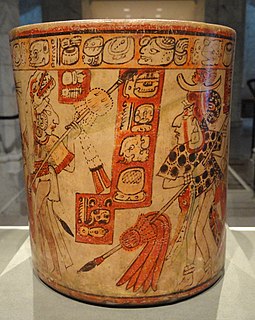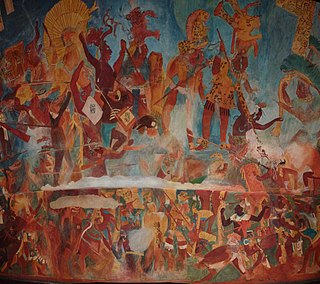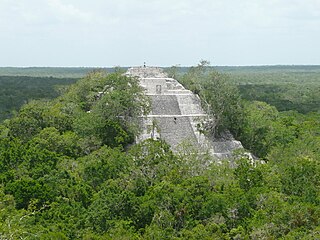
Yik'in Chan K'awiil also known as Ruler B, Yaxkin Caan Chac and Sun Sky Rain,, was an ajaw of the Maya city of Tikal. He took the throne on December 8, 734.

B'alaj Chan K'awiil was a Maya ruler of Dos Pilas. He is also known as Ruler 1, Flint Sky God K and Malah Chan K'awil.

K'ahk' Ujol K'inich I was a king of Maya city of Caracol in Belize, named after the Sun deity called Kinich Ahau. He is also known as Ruler I and Smoking Skull I. He reigned c. AD 470.

Yajaw Te' K'inich II was a king of the Mayan state Caracol in Belize. He was also known as Ruler III, Lord Water and Lord Muluc and reigned AD 553-593>.

K'an II was a Maya ruler of Caracol. He reigned AD 618–658.

Yuknoom Ch’een I was the first known Maya king of the Kaan Kingdom. He was maybe a father of King Tuun K'ab' Hix.

Tuun Kʻabʻ Hix was a Maya king of the Kaan Kingdom.

Yuknoom Head was a king of the Maya Kaan Kingdom. He ruled AD 630-636.
Yuknoom Ch'een II', known as Yuknoom the Great, was a Mayan ruler of the Kaan kingdom, which had its capital at Calakmul during the Classic Period of Mesoamerican chronology.

Yuknoom Yich'aak K'ahk' ) or Yuknoom Ixquiac was a Maya king of the Kaan kingdom, which had its capital at Calakmul during the Classic Period of Mesoamerican chronology.

Yuknoom Took' Kʻawiil was a Maya ruler of the Kaan kingdom (Calakmul).

Wamaw K'awiil was an 8th century Maya ruler of Kaan (Calakmul).

Bolon K’awiil II was a Maya king of Calakmul (>771-789?>). His monuments are Stelae 57 and 58 in his city.

Dzibanche is an archaeological site of the ancient Maya civilization located in southern Quintana Roo, in the Yucatan Peninsula of southeastern Mexico. Dzibanche was a major Maya city and investigations in the first decade of the 21st century indicate that it was the early capital of the Kan dynasty, which later ruled from the great city of Calakmul. Dzibanche features the earliest known use of the Kaan dynasty emblem glyph.

The Tikal–Calakmul wars were a series of wars between Tikal and Calakmul. The First Tikal–Calakmul War was the first of these wars. During this and following conflicts in Petén vassal states like Naranjo and Dos Pilas were often used. Though Yaxchilan was in the war it only had a minor presence at the beginning.

The Tikal–Calakmul wars were a series of wars, mainly between Tikal and Calakmul on the Yucatán Peninsula, but also with vassal states in the Petén Basin such as Copan, Dos Pilas, Naranjo, Sacul, Quiriguá, and briefly Yaxchilan had a role in initiating the first war.














